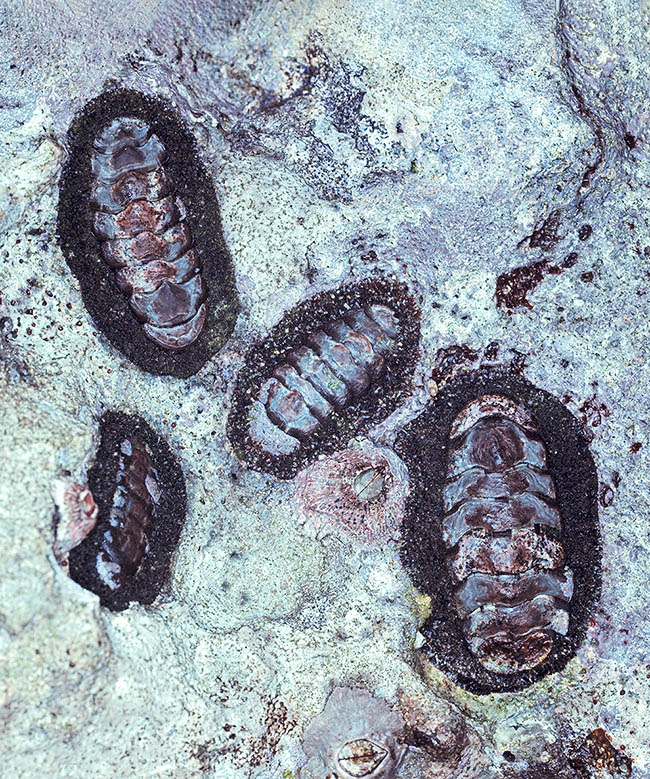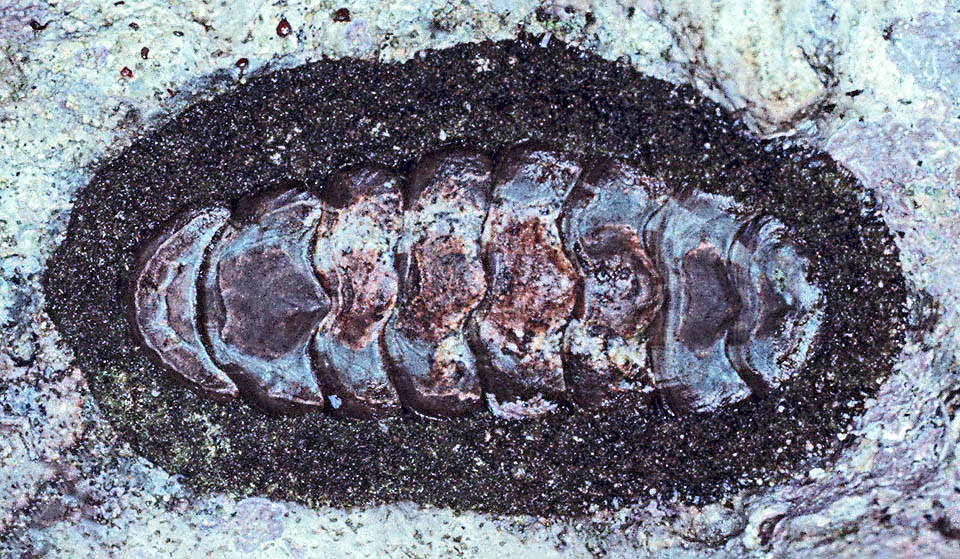Family : Chitonidae

Text © Dr Domenico Pacifici

English translation by Mario Beltramini

Acanthopleura testudo is a mesolittoral mollusk that lives between the ebb and high tide, here surprised in the open, stuck on a rock. It is frequent along the coasts from Mozambico, Madagascar and Aldabra up to the Seychelles © Giuseppe Mazza
Acanthopleura testudo Spengler, 1797 is a mollusk belonging to the family Chitonidae, a very old group of animals dating back even to the Cambrian period (500 million years ago).
Their particular shape and the powerful protective plaques surely recall the fossils of the great extinct animals of the past, besides giving the name to the class of belonging, the Polyplacophora.
The name Acanthopleura testudo refers to the characteristic ring that encloses the plaques standing above the body of the mollusk.
The genus Acanthopleura in fact comes, in Greek, from “ἄκανθος” (àcanthos), “provided with spines”, and “πλευρά” (pléura), that means “side”, whilst the specific epithet testudo, in Latin, means “turtle”.
Zoogeography
Acanthopleura testudo is not a very distributed species with a greater concentration around the African coasts of Mozambico, of Aldabra Island and the Seychelles, and a more limited concentration in the Red Sea.
Ecology-Habitat
The specimens of this species live in the marine environment defined mesolittoral, located between the levels of low and high tide and characterized by sudden changes in salinity and exposure to the sun, characteristics that render this part of the sea one of the most difficult to populate.
They are herbivorous animals and go grazing the weeds present on the coastal rocks during the night hours in order to elude the predators and the heat of the sun.
Conversely, during the day, they burrow inside the crevices of the rocks where they stand feeding waiting for the environment conditions to get milder and more favourable.
Morphophysiology
Acanthopleura testudo is a small sized animal, around 7 cm, and presents the primitive characters typical to this group of sea organisms such as the dorsal shell formed by 8 articulated plaques enclosed by a ring. This last element, which may vary in shape from species to species, is an element essential for their classification. In Acanthopleura testudo it is of dark colour with short spines decorating its surface.

Active by night, to evade predators and the heat of the sun, it eats the weeds present on the rocks, burrowing during the day into the ravines © Giuseppe Mazza
On the plates are present several small pores from where do get out the exteroreceptors, cells of sensory natura that communicate through nervous fibres, necessary for the exploration and the analysis of the surrounding environment. Moreover, ventrally, they have a muscular foot with which they perfectly anchor to the rocks in order to resist the violent waves that characterize this environment.
Ethology-Reproductive Biology
These particular mollusks have separate sewes and the fecundation is external with the release of gametes in the sea environment or in the cavity of the mantle of the female. Trochophoric larvae develop from the eggs, characterized by a ciliate circular band in the oral zone that facilitates the shifts and moves the nutrients towards the mouth.
Synonyms
Acanthopleura afra Rochebrune, 1882; Acanthopleura brevispinosa G. B. Sowerby II, 1840; Chiton borbonicus Deshayes, 1863; Chiton brevispinosus G. B. Sowerby II, 1840; Chiton cunninghami Reeve, 1847; Chiton testudo Spengler, 1797.
→ To appreciate the biodiversity within the MOLLUSCS please click here.
